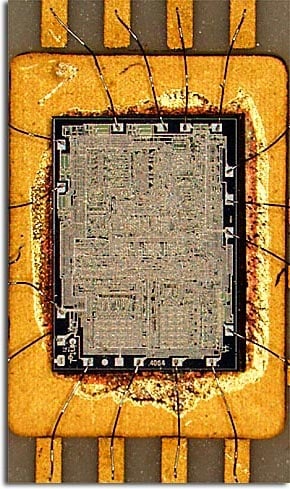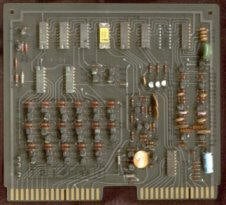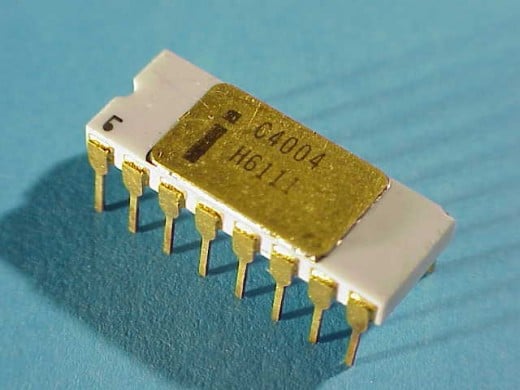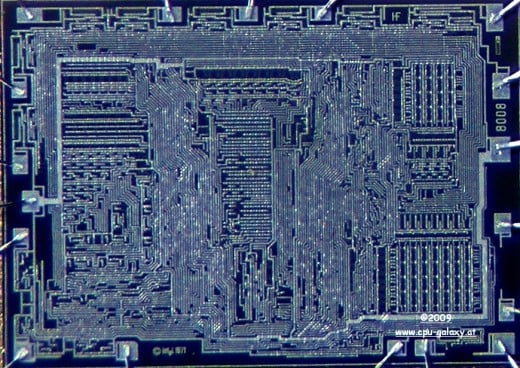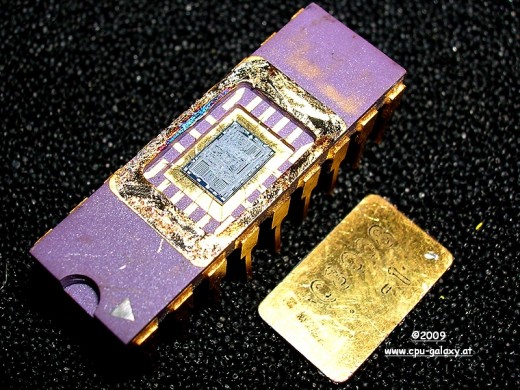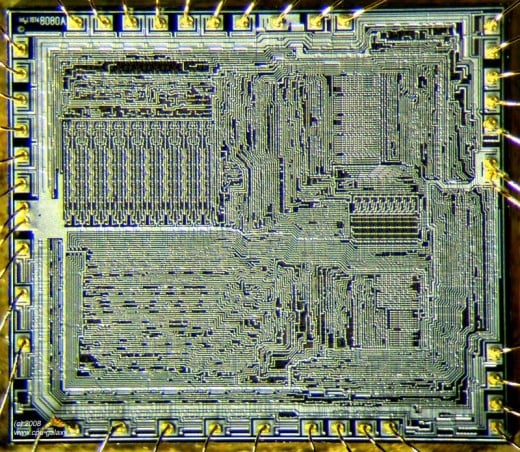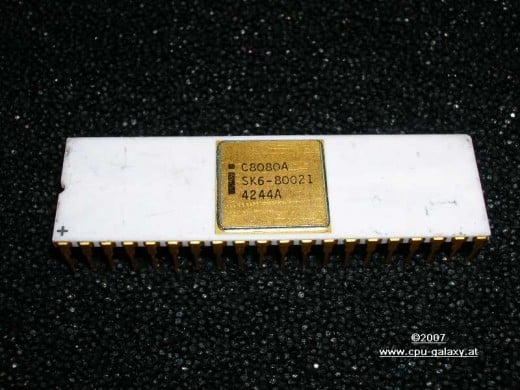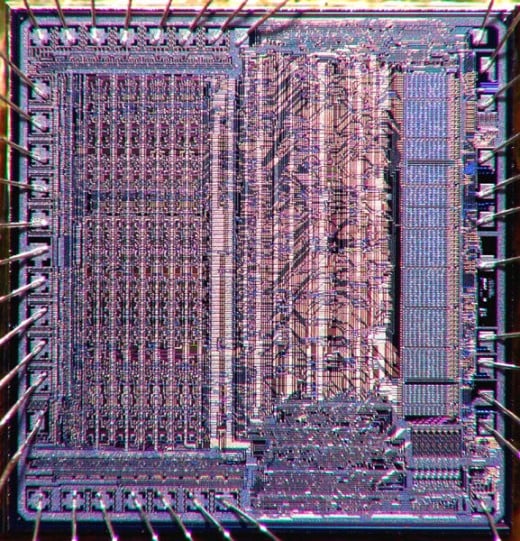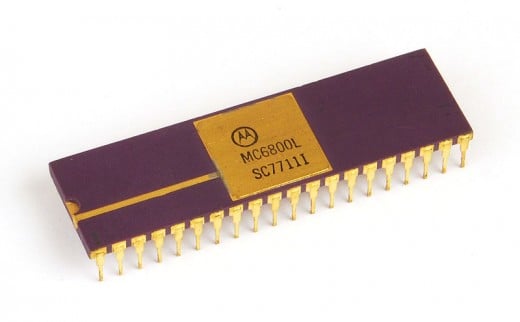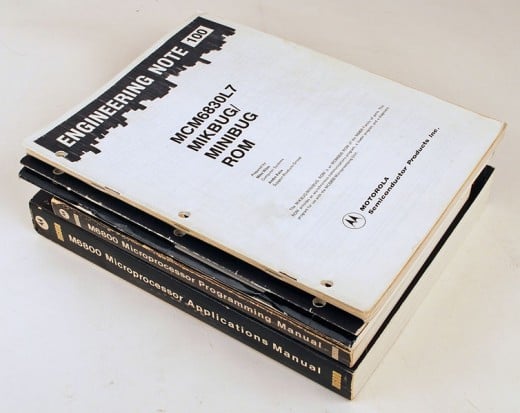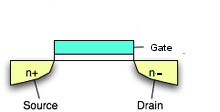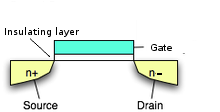- HubPages»
- Technology»
- Computers & Software»
- Computer Hardware
The Progression of Microprocessors - Part One
Microsprocessors, A Progression
March 15, 2011
In the last few days I've written an article on transisors; what they are and why they are important. That inspired me to look at microprocessors of the last thirty or so years, since microprocessors are almost entirely transistors and are in just about every electronic device you can name.
I thought I'd write an article on it, but realized I'd need more than one to really cover the topic.
As always I'll try to write this for the lay-person and attempt to explain as I go along. If I'm not successful or you have an issue with something I've written please let me know in the comments section.
Thanks!
Intel
Intelligent Electronics (Intel) will be the primary focus of this first article though I'll also need to cover Motorola's microprocessors as well. This is primarily because in the early days Intel was at the forefront of microprocessor design.
As these articles progress the companies covered will expand to Advanced Micro Devices, Texas Instruments, Samsung, nVidia and so on. I'll try to include pictures of the actual processor cores and attempt to give you some idea of scale as I go along.




Intel's 4004
This was really an accident of sorts. Intel was not trying to create the first commercially viable microprocessor, but a contract pushed the company in that direction.
Before Intelligent Electronics (Intel) designed this chip, a lot of computer scientists were talking about computers on a chip (memory already came in chip form), but no one really thought of a viable application for such a thing. Up to then computers were built out of larger components, but no one had seriously considered creating an entire computer on a single piece of silicon for commercial purposes. Certainly it was just a matter of time, but a business deal caused Intel to create the first one.
In 1970, Intel did it because they had an order for twelve chips. Unfortunately, the company did not have the facilities to manufacture that many discrete devices. Busicom, the company that wanted these chips, was planning to build an advanced calculator and needed that many for the design. Up to then Intel manufactured memory chips for major computer makers, but had not delved into manufacturing microprocessors.
Two of Intel's engineers, Ted Hoff and Federico Faggin thought they could create one chip that did all twelve functions. To do that the chip would have to be programmable; a microprocessor.
Intel came up with the design and presented it to Busicom, but that firm had financial problems and eventually filed for bankruptcy. Intel wisely bought back the license for the design for sixty thousand dollars (an almost unheard of sum in those days). Busicom eventually went under and Intel sold the 4004 to a wide variety of American businesses as the heart of calculators, and other complex calculating devices.
The Intel 4004 had two thousand three hundred (2,300) transistors in its design. It operated anywhere from 500~750 KiloHertz. And it's design incorporated a P-Channel silicon based Metal Oxide Semiconductor as gate.


Intel 8008
Intel's second processor was the 8008 and was actually developed at the same time as the 4004. Computer Terminal Corporation (CTC) had contracted for the design as the core of a smart terminal they were building. Unfortunately, the 8008 wasn't as fast as CTC wanted it to be and the design "flopped." That certainly did not keep Intel from retaining rights to the design and selling it as a "hobbyist" processor through magazines like Popular Electronics and Radio Electronics.
The 8008 had even more transistors on it than the 4004 at three thousand four (3,400) hundred. It operated at 500 Kilo-Hertz and later models up to 800 Kilo-Hertz. It, like the 4004 used P-Channel Metal Oxide Semiconductor gates on a silicon base.


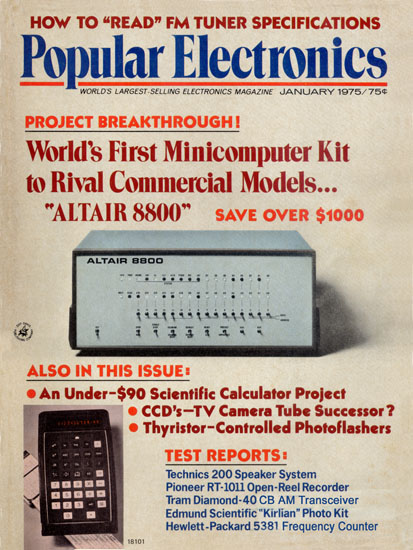
Intel 8080
The Chip that Changed the World
This microprocessor was a first on many levels. It was the first, by Intel to break the MegaHertz speed barrier, it was the first to use N-Channel Metal Oxide Semiconductor on silicon, and it was the first to be adopted by the hobbyist computer community in the Altair 8800.
This was such a successful product by Intel that they manufactured it for many years steadily improving both its function and performance.
The first chip, introduced in April of 1974 hit clock speeds of two MegaHertz (2MHz) vastly exceeding the speed of the 8008. It also packed more transistors in the same space as the 8008 and nearly doubled the total number of transistors on a chip. In fact it had six thousand (6,000) to the 8008s thirty four (3,400) hundred.
It used N-Channel Metal Oxide Semiconductor gates on a silicon substrate and was a full eight bit processor unlike the 4004 which was four bit.
But perhaps its biggest claim to fame was as an essential component to the very first kit built microcomputer to ever be offered to the public.
The Altair 8800
During 1974 Popular Electronics magazine had gone through a change in management; it had merged with another Ziff-Davis publications magazine called Electronics World. A number of its authors defected to Radio Electronics magazine, a competitor and Popular Electronics was losing subscriptions and readership to the arguably better articles suddenly appearing in Radio Electronics. RE was offering monthly instructions on kit built radios, calculators and computer precursors.
In an effort to bring readership back Popular Electronics editor Art Salsberg insisted that the magazine do its own series of kit electronics. Les Solomon, another editor, knew Micro Instrumentation and Telemetry Systems (MITS) was working a computer based on an Intel chip and contacted the company. Ed Roberts and Bill Yates of MITS finished a prototype and shipped it to Popular Electronics by rail, but as luck would have it the computer was lost in shipment.
Undaunted Ed Roberts got to work building a replacement. Roberts had considered the Intel 4004 and the 8008, but knew they weren't powerful enough. He also considered the National Semiconductor IMP-8 and IMP-16, but both these processors weren't really "computer on a chip" designs. Motorola was still working on the 6800 so that was out.He finally settled on the Intel 8080.
When Roberts contacted Intel they offered him the chip for $360 per unit, by Intel's reasoning this was a fair price; it was a computer after all. But Roberts had years of experience dealing with Original Equipment Manufacturers (OEMs) and worked the price down to $75 per chip.
When the Roberts' version of the Altair was finally ready in kit form the entire project cost $400 or could be purchased pre-assembled for $621.
Just in Time for Christmas
Because the January 1975 issue of Popular Electronics actually hit news-stands in December of 1974 just before Christmas timing for the kit was perfect. By February 1974 MITS had orders for 1,000 units (Roberts had decided that 200 unit sale was a break-even point for MITS), and MITS had sold and delivered 2,500 by the end of May. By August the number was 5,000. In that period MITS staff grew from twenty employees to ninety.
Despite the stellar sales the Altair was sold at cost. Roberts and staff figured to make a profit on selling memory boards and other peripherals; which they did. Because the base Altair only had one memory board an additional board and an interface board was needed to run the BASIC language which was introduced for the machine in July 1974. An additional memory board cost $338 and the parallel memory board cost $114. These two boards together exceeded the cost of the Altair as a kit, but were sold at a profit unlike the computer itself.
MITS Can't Keep Up
The Altair's popularity eventually doomed it when MITS could not keep up with demand for the computer and boards. Eventually one of the purchasers of the original Altair kit computer, Robert Marsh, began manufacturing his own memory boards at $225 per. These boards were 100% compatible with the Altair 8800. Processor Technology, Marsh's company, quickly began bleeding sales away from MITS.
More Competition
IMS Consulting in San Leandro California wanted to use the Altair 8800, but were put off by the long delays in shipment from MITS. They decided to build their own microprocessor based computer and called it the IMSAI 8080. The IMSAI was superior in design, doing away with some of the basic problems with the Altair and the computer was introduced to the public in the October issue of Popular Electronics. MITS countered with the Altair 8080B and the race was on.
Eventually MITS made a profit, but more notably they changed the landscape for computers and users. Suddenly anyone, not just a university or company, could own a computer.



Motorola 6800
About the time Intel was cranking out 8080 processors Motorola was working on their own. Unlike the Intel 8080, the 6800 operated on one voltage (5 volts) not three, it also had a clock rate of one MegaHertz, and had a full sixteen bit bus (unlike the 8080's eight bit bus) meaning it could process twice the data of the 8080 at the same clock speed.The MC6800 used N-Channel Metal Oxide Semiconductor material on silicon in its manufacture. It had four thousand (4,000) transistors to the 8080s six thousand (6,000).
Foundry Problems
Motorola had some real manufacturing problems in the beginning. The chip was larger than most and the number of chips that could be produced per silicon wafer was reduced because of this. Additionally, the larger the chip the more likely it was to have shorting problems. At one point only about 25% of Motorola's MC6800 were viable with the other 75% being deemed junk and relegated to the trash. Eventually Motorola came up with a better manufacturing process (discussed in Part Two) which reduced the failure rater considerably.
Unlike the Intel design the Motorola chip was designed from the beginning to emulate an already established and popular computer; the Digital Equipment Corporation (DEC) PDP-11. Motorola also provided an assembly language development system so hobbyists could begin programming "out of the box." In fact Motorola was quite generous with supplied documentation. On request the purchaser could get a seven hundred page manual explaining how to construct a point-of-sale terminal incorporating the 6800 in it's design.
The 6800 found its way into the Tektronic 4051 Graphic Computing System. Later iterations of the 6800 found their way into Heathkit trainers, the Radio Shack TRS-80 Color computer, and the Dragon 32/64 in Europe.


Terms
All of the computer chips mentioned above used N-Channel or P-Channel Metal Oxide Semiconductor transistor technology in their manufacture. In truth, the transistors (and all processors are primarily a collection of transistors) were Field Effect type transistors so they were called MOSFET or Metal Oxide Semiconductor Field Effect Transistors.
What this means is (see image at right) that the transistor switches on or off by changing the effect of a field over or near the source and drain that are the channels of electrical flow in a transistor. Earlier transistors used point contact gates which means they allowed current flow directly through the gate from the source to the drain.
Field effect transistors, on the other hand, allowed current flow through the silicon substrate if the current on the gate (floating above the source and drain) allowed a field effect causing the flow of electrons between the source (side with the supply voltage) to the drain (side the current flowed to).
Source: The side of the transistor where electric current is held or is the source of the current flowing through a switched on transistor.
Drain: The side of the transistor where current flows when the transistor is switched on.
Gate: The region of the transistor that controls current flow from the source to the drain.
Dual Inline Package: A package for a chip with two parallel sets of pins which are inline. The number of pins is always an even number due to the fact that there are the same number on both sides, however, the total number of pins can change from package to package.
P-Channel:This is a transistor that operates with a positive voltage on the the source.
N-Channel:This is a transistor that operates with a negative voltage on the source.
MOS: Metal Oxide Semiconductor. The base surface of this type of transistor is silicon. The portions that form conducting pathways are metal oxides such as aluminum oxide, gallium arsenide, and so on.
MOSFET: This is a transistor designed in such a way that the gate is insulated from the source and drain by a layer of non-conducting material. When voltage is applied to the gate current will flow through the insulator. This form of transistor was widely used because it will not conduct electricity in the reverse direction.
Coda
With the exception of the MC6800 by Motorola, and even this chip in many cases, all of the microprocessors presented here were designed to be used in kit-built hobbyist computers. The next in the series, The Progression of Microprocessors - Part Two will cover those microprocessors designed and built to be heart and parcel to the next line of personal computers, those that could be purchased off the shelf as complete, ready to use personal/home computing devices.
During this time the number of transistors per chip increased geometrically, clock speeds broke new records, the computers became cheaper and more and more people could afford to buy them.
Disclaimer
The author was not compensated in any way, monetarily, with discounts, or freebies by any of the companies mentioned.
Though the author does make a small profit for the word count of this article none of that comes directly from the manufacturers mentioned. The author also stands to make a small profit from advertising attached to this article.
The author has no control over either the advertising or the contents of those ads.


